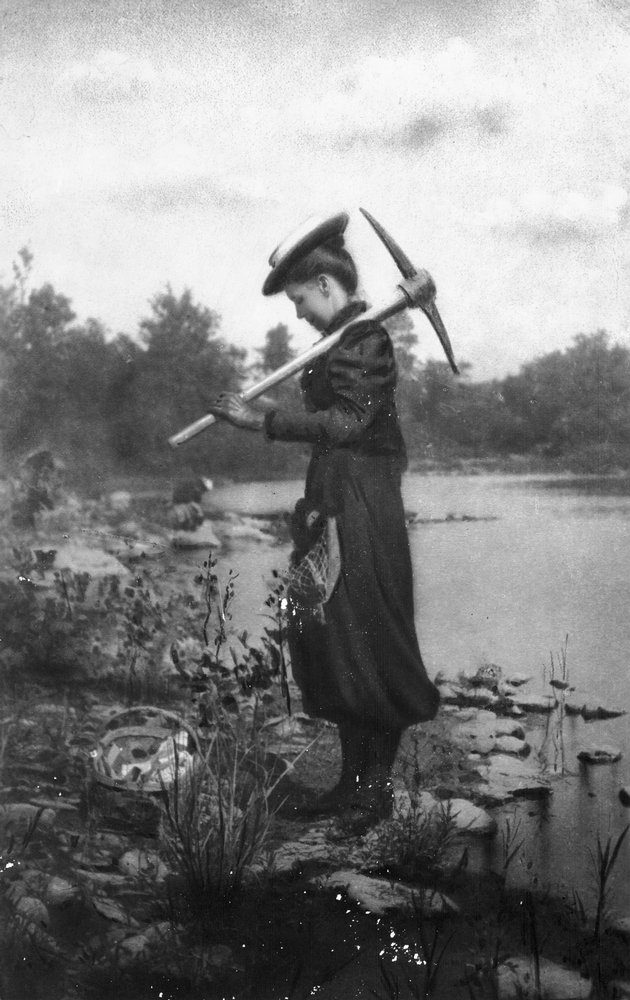Fossil Dress Codes
by Dr. Alexandra Moore, Senior Research Associate
March 22, 2022
Try this: Fire up your favorite search engine and type in “women arrested for wearing pants.” The results go on for pages; some pieces are authoritative, others lean more toward click-bait. But the underlying fact is that beginning in the 1840s cities and states in the U.S. enacted masquerade laws that prohibited individuals from appearing in public in "dress not belonging to his or her sex."
Newspaper article in The Brooklyn Daily Eagle, September 3, 1913.
I grew up a tomboy, always preferring pants to dresses; in fact I still do. I couldn’t imagine doing all the things I loved – including fossil hunting with my Dad – if I was wearing a dress. Early women pioneers in the fields of geology and paleontology preceded me in this regard. It is easy to find photographs of paleontologist Annie Alexander (1867-1950) wearing knickerbockers, in fact, the opening photo on Annie’s Wikipedia page is an example. And one of my favorite photographs of all time is bloomer-clad geologist Zonia Baber (1862-1956) in the field collecting fossils in 1895. For me, Baber’s emphasis on teaching in the field qualifies her as a rock star in the literal sense of the word.
Zonia Baber collecting fossils in 1895 at Mazon Creek, Illinois. Credit: University of Chicago Photographic Archive, [apf1-00303], Hanna Holborn Gray Special Collections Research Center, University of Chicago Library.
Anthropologists trace the origin of pants to Scythian nomads who crafted them for horseback riding 3000 years ago. Excavations of burials show that both men and women wore them. How did we go from horsewomen in trousers to masquerade laws? And where do early American women scientists fit in?
The U.S. legal system came to this continent from England, arriving with the early colonists and codified in the U.S. Constitution. Enforcing dress codes through law is one way of identifying and maintaining social classes, cultural identities, power structures and gender roles. In the mid-19th century women began to push back against the laws and social customs that defined their roles. The most widely recognized of these are the suffragists who met in 1848 at the first Women’s Rights Convention in Seneca Falls, NY. These women were among the first to adopt bloomers – baggy, knee-length pants with a short overskirt – as a more comfortable and practical style of dress. The look was popularized by Amelia Bloomer in her feminist newsletter, The Lily.
Women who wished to pursue careers or avocations outside of those deemed ”suitable” at the time, and particularly in disciplines like geology and paleontology for which fieldwork was an important first step, also adopted bloomers and pants as appropriate garb. New York State Paleontologist Winifred Goldring (1888-1971) made her own clothes for working in the field.
Winifred in field gear at Mount Rainier National Park in Washington, July 1928. Source: New York State Museum.
Most modern women are familiar with the uncomfortable and unflattering fit of men’s pants, and Winfred did not have access to off-the-rack women’s outdoor gear. I am curious as to whether Winifred thought about being a lawbreaker when she wore pants in the field. Although, as an upper middle class white woman working for the state of New York she probably wasn’t running much risk of arrest. And in other photos and biographies she seems to have followed our suffragist predecessors in pushing boundaries, or perhaps she was a “disturber,” like Elizabeth Trondle, in that we see her riding in a motorcycle sidecar, and read of her activism on behalf of equal pay for women.
The masquerade laws that appeared in the mid-1800s have remained stubbornly persistent in state and local legal codes, as they target both women and men who dress outside of gender norms. For example several New Jersey townships struck down an array of these statutes as recently as 2010-2015.
The author, a lawbreaker in 1968.
Most of us who grew up in the 1960s, 70s and beyond don’t think much about wearing pants, even with dusty masquerade laws still on the books. Annie, Zonia and Winifred are all remembered for both their scientific contributions and for breaking the trail for women whose passion is to immerse ourselves in the natural world and understand its beauty and complexity. Cornell science historian Margaret Rossiter wrote, ““As scientists they were atypical women; as women they were unusual scientists.” And not least, these atypical women are remembered for their unusual dress.





